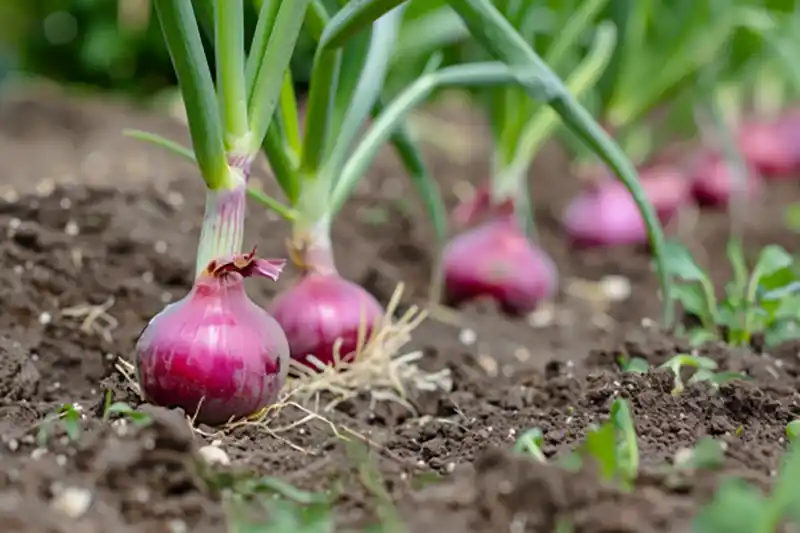Guide to Growing Robust Onions: Techniques and Nutrients for Success
Growing onions can be a satisfying endeavor with the right techniques and supplemental care. This guide covers essential steps and nutrients to help you cultivate healthy, high-yielding onions.
Choosing the Right Onion for Planting
1. Select Healthy Bulbs:
- Characteristics: Choose firm, healthy bulbs without soft spots or signs of rot.
- Seeds vs. Bulbs: Planting from seeds is often preferred as these onions tend to adapt better to local climates and can offer a wider range of varieties.
Preparing the Soil
1. Enrich the Soil:
- Organic Matter: Onions thrive in soil rich in humus, compost, and manure. These additions improve soil fertility and structure.
- Soil Preparation: Loosen the soil to a depth of about 12 inches and mix in organic matter to enhance nutrient availability.
2. Using Mycorrhiza:
- Benefit: Mycorrhiza are beneficial fungi that enhance nutrient absorption.
- Application: Add approximately 5 grams of mycorrhiza per plant, placing it directly under the onion bulb to establish a connection with the plant’s roots.
3. Applying Wood Ash:
- Advantages: Wood ash acts as a natural pest deterrent and adds calcium and potassium to the soil.
- Application: Sprinkle wood ash around the planting area before planting. This helps create a protective barrier and boosts soil fertility.
Planting Onions
1. Planting Depth:
- Technique: Plant onions shallowly, with the bulb just below the soil surface.
- Procedure: Create small holes about the size of your fist, place a bit of mycorrhiza at the bottom, position the bulb with the root end down and the tip up, and lightly cover with soil.
2. Companion Planting:
- Beneficial Companions: Plant onions alongside carrots and parsley to naturally repel pests.
- Rotation: Avoid planting onions in the same spot each year to prevent soil depletion and disease buildup. Rotate with crops like tomatoes or squash.
Supplementing Nutrients for Large, High-Quality Onions
1. Early Stage Feeding:
- Nutrient Needs: Focus on strong leaf growth with a balanced fertilizer (10-10-10 or 6-4-8).
- Timing: Apply the first feeding up to the fourth week after planting, ensuring onions receive about 40% of their nitrogen, potassium, and calcium needs.
2. Mid to Late Stage Feeding:
- Bulb Development: As bulbs form, shift the focus to potassium and phosphorus to support bulb growth and quality.
- Foliar Feeding: Apply liquid fertilizers rich in calcium, potassium, and micronutrients directly to the leaves. This method is particularly effective during dry periods.
3. Foliar Feeding with Wood Ash Solution:
- Preparation: Dissolve 100 grams of wood ash in 1 liter of water. Let sit for a few hours, then dilute with 9 liters of water.
- Application: Spray the solution directly on the onion leaves early in the morning or late in the evening to avoid leaf burn and maximize nutrient uptake.
Regular Care and Maintenance
1. Watering and Mulching:
- Consistency: Onions need regular moisture, especially during bulb formation. Mulching with straw helps retain soil moisture, reduce weeds, and lessen watering frequency.
- Watering: Water thoroughly but avoid overwatering to prevent root rot.
2. Final Tips for Successful Onion Growth:
- Crop Rotation: Rotate crops annually to prevent soil depletion and disease.
- Soil Testing: Regular soil tests help assess nutrient levels and adjust fertilization plans.
- Organic Supplements: Consider using organic products like Black Up® to improve soil structure and nutrient absorption. It’s suitable for organic farming and enhances overall plant health.
By following these guidelines, you can cultivate robust onion plants that yield high-quality bulbs. From selecting the right varieties and preparing the soil to effective nutrient supplementation and care, these practices will help you achieve a bountiful and satisfying onion harvest. For further insights, explore additional resources and expert advice tailored to your specific growing conditions. Happy gardening!

